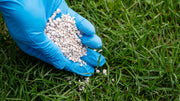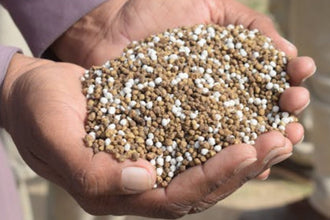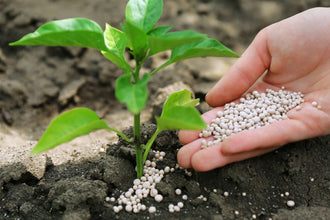
Understanding fertilizer numbers meaning is something every gardener needs to know, but most of us just grab whatever bag looks good at the store. Those three numbers on fertilizer packages actually tell you exactly what your plants will get to eat. Once you figure out what they mean, you'll never buy the wrong fertilizer again.
You've probably stood in the garden center looking at all those bags with different numbers like 10-10-10 or 4-2.5-2, wondering which one will actually help your plants grow better. Maybe you've even bought the one with the biggest numbers, thinking more must be better. Well, that's not always true, and understanding these numbers can save you money while making your garden way healthier.
The truth is, fertilizer numbers work like a recipe for plant food. Just like you wouldn't put the same spices on every dish, you shouldn't use the same fertilizer for every plant. Some plants are heavy feeders that want lots of nutrients, while others prefer a lighter touch.
What Those Three Numbers Actually Tell You
Fertilizer numbers show you the percentage of three main nutrients in every bag or bottle. These numbers always appear in the same order, which makes shopping much easier once you know the system. The first number is nitrogen, the second is phosphorus, and the third is potassium.
So when you see a fertilizer labeled 4-2.5-2, you're looking at 4% nitrogen, 2.5% phosphorus, and 2% potassium. The rest of the bag contains other stuff like filler materials and trace nutrients that plants need in smaller amounts. Think of it like a vitamin that's mostly filler but contains the important stuff your body needs.
The NPK System Makes Shopping Simple
This system has been around for decades because it works. Every fertilizer manufacturer has to follow the same rules, so you can compare products easily. A 10-10-10 fertilizer gives equal amounts of all three nutrients, while a 4-2.5-2 blend provides more nitrogen compared to the other two.
Understanding fertilizer numbers meaning gets easier when you remember that plants are like people with different appetites. Some want lots of protein (nitrogen), others need more energy foods (phosphorus and potassium). The ratio tells you what kind of meal you're serving your plants.
Companies have to test their products to make sure the numbers on the bag match what's inside. The percentages are actually minimums, so you might get a little extra but never less than what's promised. This keeps things fair and helps you plan how much to use.
Nitrogen: The Green Machine
Nitrogen makes plants grow green and leafy. It's like giving your plants a shot of energy that makes them grow faster and look healthier. Most fertilizers have more nitrogen than anything else because plants use tons of it, especially during spring growth spurts.
The first number in any fertilizer formula tells you how much nitrogen boost your plants will get. A fertilizer with 4% nitrogen gives a nice, steady feeding without going overboard. Higher numbers work great for lawns and vegetables that need to grow quickly, but they can burn young plants if you're not careful.
Here's something important about nitrogen: it doesn't stick around in the soil very long. Rain washes it away, especially in sandy soil. That's why you need to reapply nitrogen fertilizers more often than you might think.
How Plants Actually Use Nitrogen
Plants can eat nitrogen in two different forms: nitrate and ammonium. Both work fine, but they act differently in the soil. Nitrate moves around with water, while ammonium sticks to soil particles and gets released slowly.
Organic fertilizers like composted manure release nitrogen gradually as tiny soil creatures break everything down. This slow release works better for most plants because it gives them a steady supply instead of a huge meal all at once. Understanding fertilizer numbers meaning includes knowing that the source matters just as much as the percentage.
When plants get too much nitrogen at once, they grow too fast and become weak. It's like eating too much candy - you get a quick energy rush followed by a crash. Plants with steady nitrogen supplies stay healthier and resist diseases better.
Phosphorus: The Root Builder
The middle number shows phosphorus content, and this nutrient builds strong roots and helps plants make flowers and fruits. Young plants especially need good phosphorus to get their root systems established. Without enough phosphorus, plants stay small and weak no matter how much water and sun they get.
Unlike nitrogen, phosphorus doesn't move around much in the soil. It sticks close to where you put it, which means you need to mix it into the root zone instead of just sprinkling it on top. Many gardeners make the mistake of applying phosphorus fertilizer to the soil surface where it can't help much.
Most garden soils already have plenty of phosphorus, so you don't always need fertilizers with high phosphorus numbers. A soil test can tell you what you really have, but for most situations, the 2.5% phosphorus in a 4-2.5-2 fertilizer provides plenty without overdoing it.
What Phosphorus Does for Plants
Phosphorus helps plants move energy around inside their cells and build DNA. Plants need the most phosphorus when they're growing fast, like when seedlings are getting established or when flowers are forming. Too little phosphorus means poor root growth and fewer flowers.
But here's a surprise: too much phosphorus can actually hurt root development and make plants less able to handle dry conditions. It can also mess with how plants absorb iron, causing yellow leaves even when everything else looks fine.
Understanding fertilizer numbers meaning includes knowing that balance matters more than big numbers. Plants that get steady, moderate amounts of phosphorus usually outperform plants that get huge doses occasionally.
Potassium: The Plant Protector
Potassium, shown as the third number, helps plants stay healthy and fight off diseases. It strengthens cell walls and helps plants manage water better. Plants with good potassium levels handle hot weather, cold snaps, and dry spells much better than plants that don't get enough.
The 2% potassium in a 4-2.5-2 fertilizer gives plants steady support for all their health functions. Potassium moves through soil at a medium speed, staying available longer than nitrogen but not getting stuck like phosphorus. This makes it pretty easy to manage in most gardens.
Potassium becomes super important when plants are making fruits or getting ready for winter. Tomatoes and peppers need extra potassium to make tasty, disease-resistant fruits. Lawns benefit from fall potassium applications that help grass survive winter and come back stronger in spring.
Why Potassium Keeps Plants Healthy
Potassium controls over 80 different processes inside plant cells. These processes handle photosynthesis, protein building, and sugar production. Plants that don't get enough potassium show yellow leaf edges, weak stems, and poor fruit quality.
Different potassium sources work differently too. Organic sources like compost release potassium slowly while making the soil better overall. Chemical sources work fast but don't improve soil health. The best approach uses both types for quick results and long-term benefits.

Picking the Right Fertilizer Numbers for Your Plants
Different plants want different nutrient mixes depending on what they're trying to do. Leafy vegetables like lettuce love nitrogen-heavy fertilizers, while flowering plants prefer more phosphorus and potassium. Understanding fertilizer numbers meaning helps you match the right food to each plant's appetite.
A balanced fertilizer like 10-10-10 works okay for general use, but specific ratios often work much better. The 4-2.5-2 ratio you'll find in good organic fertilizers gives excellent all-around nutrition without overfeeding anything. This gentler approach keeps plants growing steadily while building better soil over time.
Your soil type affects how fertilizer numbers translate into actual plant growth. Sandy soils need more frequent feeding because nutrients wash away quickly. Clay soils hold onto nutrients longer but might need help with drainage. Adding organic matter helps any soil use fertilizers more effectively.
Matching Fertilizers to What You're Growing
Here's a quick guide for different plant types:
Lawn Grass:
-
Spring: Higher nitrogen ratios like 3-1-2 for green growth
-
Fall: Balanced nutrition with extra potassium for winter prep
-
Established lawns: Moderate numbers work better than high-power blends
Flowering Plants:
-
Early season: Balanced nutrition to get established
-
Blooming time: Lower nitrogen, higher phosphorus ratios
-
Perennials: Gentle feeding with organic fertilizers
Vegetable Gardens:
-
Leafy crops: Higher nitrogen for green growth
-
Fruiting plants: Balanced early, then more potassium for fruit development
-
Root vegetables: Lower nitrogen to avoid all leaves and no roots
Trees and Shrubs:
-
Young plants: Moderate nitrogen to establish growth
-
Mature plants: Balanced nutrition with less nitrogen
-
Fruit trees: Extra potassium during fruit development
What Most People Get Wrong About Fertilizer Numbers
The biggest mistake people make is thinking higher numbers always mean better results. A 20-20-20 fertilizer has way more nutrients than a 4-2.5-2 blend, but that doesn't make it more effective. Plants can only use so much food at once, and extra nutrients often wash away or cause problems.
Another common mistake is ignoring your soil when choosing fertilizer ratios. Understanding fertilizer numbers meaning includes knowing that soil pH, organic matter, and existing nutrients all affect how plants respond. A soil test gives you the real story about what your plants actually need.
Timing matters just as much as nutrient ratios. High nitrogen fertilizers work great in spring when plants start growing, but they can mess up winter preparation if you use them too late in the season. Fall fertilizers should focus on phosphorus and potassium instead of nitrogen.
Why Less Can Be More
Too many nutrients cause more plant problems than too few in most gardens. Excess nitrogen creates soft, weak growth that bugs and diseases love to attack. Too much phosphorus interferes with iron uptake and causes yellow leaves. Understanding fertilizer numbers meaning includes knowing when to back off.
Organic fertilizers with moderate numbers like 4-2.5-2 rarely cause nutrient problems. They release nutrients slowly as soil microbes do their work. This gradual release matches what plants naturally expect and prevents the boom-bust cycle that stresses plants.
Chemical fertilizers with high numbers can overwhelm plants and soil life. They're like fast food for plants - quick energy but not much long-term benefit. Organic fertilizers with lower numbers are more like home-cooked meals that provide sustained nutrition.
Why Fancy Chicken Organic Fertilizer Gets the Numbers Right
Fancy Chicken's 4-2.5-2 NPK ratio represents years of testing and refinement to create the perfect nutrient balance for most garden situations. This organic pelletized chicken manure delivers exactly what plants need without the guesswork that comes with mixing different fertilizers or wondering if you're overfeeding your garden.
The Science Behind Fancy Chicken's 4-2.5-2 Formula
The 4% nitrogen in Fancy Chicken fertilizer provides steady green growth without causing the rapid, weak growth that synthetic fertilizers often create. This moderate nitrogen level comes from naturally composted chicken manure that releases nutrients slowly as soil microbes break it down. Plants get fed consistently over several weeks instead of getting hit with a massive nutrient dump all at once.
The 2.5% phosphorus content gives plants exactly what they need for strong root development and flower formation. Most soils already contain adequate phosphorus, so this level prevents nutrient lockup while still supporting healthy growth. Unlike synthetic phosphorus that can build up to toxic levels, organic phosphorus from chicken manure integrates naturally with soil chemistry.
Potassium at 2% provides excellent plant health benefits without overdoing it. This level supports disease resistance, drought tolerance, and fruit quality while working in harmony with existing soil nutrients. The organic potassium source means better long-term availability compared to synthetic alternatives that can wash away quickly.
What Makes Fancy Chicken Different from Generic Fertilizer Numbers
Real organic fertilizers work differently than synthetic blends, even when the numbers look similar on paper. Fancy Chicken's pelletized chicken manure contains beneficial microorganisms that synthetic fertilizers actually kill. These tiny soil helpers improve nutrient availability and create healthier growing conditions that last for months.
The pelletized form makes application easy and prevents nutrient runoff that wastes money and harms waterways. Each pellet breaks down gradually, releasing nutrients right in the root zone where plants can use them most effectively. This controlled release means fewer applications and better results compared to quick-dissolving synthetic fertilizers.
Benefits That Go Beyond the Numbers
-
Improves soil structure - Organic matter from chicken manure creates better drainage in clay soils and improves water retention in sandy soils
-
Feeds beneficial microbes - Supports the living soil ecosystem that chemical fertilizers often damage
-
Provides trace nutrients - Contains secondary nutrients and micronutrients that plants need but fertilizer numbers don't show
-
Long-lasting effects - Continues improving soil and feeding plants for 6-8 weeks after application
-
Safe for families and pets - No synthetic chemicals that could harm children, pets, or beneficial insects
Application Made Simple
Understanding fertilizer numbers meaning helps you use Fancy Chicken more effectively. Apply every 4-6 weeks during the growing season at the rate shown on the package. The pelletized form won't burn plants like high-number synthetic fertilizers can, making it perfect for gardeners who want great results without constant worry about application timing or rates.
The organic nature means you can apply it throughout the growing season without the salt buildup problems that synthetic fertilizers create. Your soil gets better with each application instead of becoming dependent on chemical inputs that cost more and work less effectively over time.
Start Feeding Your Garden the Right Way
Your plants have been waiting for nutrition that actually makes sense. Fancy Chicken's perfectly balanced 4-2.5-2 formula takes the guesswork out of fertilizing while building the kind of rich, living soil that produces amazing results year after year. Stop struggling with confusing fertilizer numbers and complicated application schedules that never seem to work quite right.
Make the switch to Fancy Chicken organic fertilizer and give your garden the steady, balanced nutrition it deserves. Your plants will show their appreciation with stronger growth, better pest resistance, and the kind of vibrant health that makes neighbors stop and ask what your secret is.








